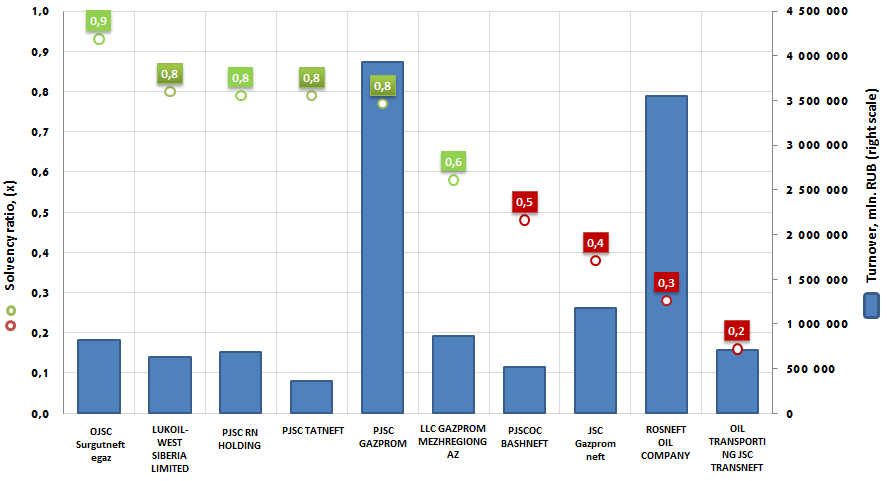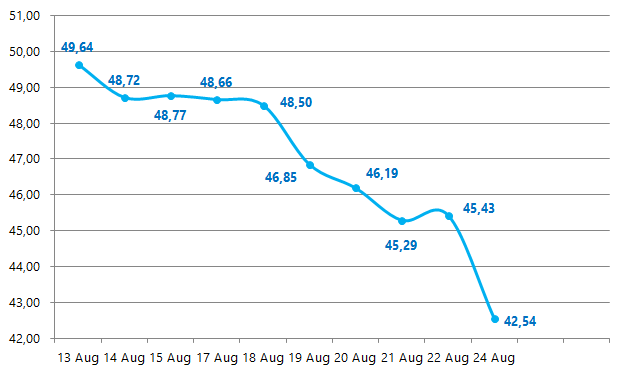Solvency ratio of oil and gas industry
Information agency Credinform prepared a ranking of companies in oil and gas industry.
Companies with the highest volume of revenue were selected for this ranking according to the data from the Statistical Register for the latest available period (for the year 2013). The enterprises were ranked by decrease in solvency ratio.
The solvency ratio (x) is equity capital to total assets. It indicates the dependence of the company on external loans.
The recommended value is >0,5.
The lower value shoes the dependence on external sources of financing and possible instability therefore.
However, sometimes the companies are able to be stable with the value lower than 0,5. They are first of all companies with high assets turnover, stable demand, established supply and distribution channels, low fixed costs (for example, trade and intermediary organizations).
The value of the solvency ratio above the optimum level indicates a high solvency.
The recognition of the company insolvent does not mean the business is automatically determined as pre-bankruptcy organizations. This is just a recorded financial instability. Therefore, the regulatory value of the criteria is established in such a way as to provide operational control of the entity's financial position and to implement the insolvency prevention measures in advance, as well as to stimulate the company for self-getting out the crisis.
For the most comprehensive and fair view on the company’s financial condition it is necessary to pay attention not only to the average values in the industry, but also to the whole presented set of financial indicators and ratios.
| № | Name | Region | Revenue, mln. RUB, 2013 г. | Solvency ratio, (х) | Solvency index GLOBAS-i® |
|---|---|---|---|---|---|
| 1 | SURGUTNEFTEGAS OPEN JOINT STOCK COMPANY INN 8602060555 |
the Khanty-Mansi Autonomous Okrug - Yugra | 814 187,8 | 0,9 | 189 the highest |
| 2 | LUKOIL-WEST SIBERIA LIMITED INN 8608048498 |
the Khanty-Mansi Autonomous Okrug - Yugra | 631 009,8 | 0,8 | 187 the highest |
| 3 | PJSC RN Holding INN 7225004092 |
the Tyumen region | 688 008,2 | 0,8 | 253 high |
| 4 | PJSC «Tatneft» INN 1644003838 |
the Republic of Tatarstan | 363 531,3 | 0,8 | 185 the highest |
| 5 | PJSC GAZPROM INN 7736050003 |
Moscow | 3 933 335,3 | 0,8 | 156 the highest |
| 6 | LLC GAZPROM MEZHREGIONGAZ INN 5003021311 |
Moscow | 867 412,1 | 0,6 | 251 high |
| 7 | PJSOC Bashneft INN 0274051582 |
the Republic of Bashkortostan | 517 486,7 | 0,5 | 196 the highest |
| 8 | JSC Gazprom Neft INN 5504036333 |
Saint-Petersburg | 1 178 063,8 | 0,4 | 188 the highest |
| 9 | ROSNEFT OIL COMPANY INN 7706107510 |
Moscow | 3 544 443,1 | 0,3 | 209 high |
| 10 | OIL TRANSPORTING JOINT STOCK COMPANY TRANSNEFT INN 7706061801 |
Moscow | 704 714,0 | 0,2 | 166 the highest |

Low global oil price – Russia only wins
The continuing trend of decrease in Brent oil price is marked at the moment. The cheapening of black gold is marked during the last 8 weeks. The quotation of Russian oil brand Urals is close to Brent’s, which is traded on London Stock Exchange. That’s why the experts are focused on the Brent brand price.
Thus, on 13 August 2015 the oil price amounted to 49,64 USD per barrel. The decline is 1,19% in comparison with previous day's trades. On 24 August 2015 the oil price decreased to 42,54 USD per barrel. This is 6,36% lower than the trade level as of 22 August 2015. The negative dynamics of oil price within 10 days is represented at picture 1.

Picture 1. The dynamics of oil prices for a period of 13-24 August 2015, USD/ barrel
According to Information Agency Credinform experts, the strongest influence on price reduction still have the following factors:
- surplus inventory of oil is daily marked at the level of 3 mln. barrels;
- decrease in global oil consumption;
- continuing increase of global oil production;
- the expectation of the Iran oil on the global market after lifting of sanctions;
- politicized and speculative price trends on the oil market.
In the short term period the decrease of oil price is the negative factor for Russia. As almost a half of Russian budget is formed on the base of oil and gas revenues, the decrease of oil price will influence on its profitable part and, as a result, the budget deficit is possible. Against this background, the following things are happen: the ruble become weak towards hard currencies, increase of the capital outflow, promotion of the next inflation round, decrease of investment volumes into economy etc.
Under the circumstances the opinions of the market experts of oil price forecast are quite different: starting from the statements of inability to predict in numbers up to the worst case, when the oil will be traded at the level of 25 USD per barrel. Some experts argue that the oil price will be within the limits of 40 - 70 USD/barrel.
The most analysts don’t believe in decrease of oil price below 40 USD per barrel or consider such situation, but for a short time. Thus in terms of the "price war" it is believed, that Russia does not need to reduce the production and sale of oil. This period must be overcome by increasing of its production and sale and thereby to deprive competitors’ initiatives. The analysis of the stress-testing results shows the ability of the Russian oil and gas companies to withstand the low oil prices. According to the management statements, the companies have enough safety margin, they generate stable cash flow to serve its financial obligations and to cover financial needs.
It also should be noted, that according to Russian and some international experts, Russia can safely live at the level of 40 USD per barrel. The budget revenues were taken into account with the annual average oil price of 50 USD per barrel and 2015 annual average ruble rate at the level of 60 RUB per dollar. Therefore, with decrease in oil price the exchange rate of the ruble against hard currencies will increase. For example, today, when the oil price is 44 USD per barrel, the exchange rate is more than 70 RUB per dollar, and this trend will continue in the future. However, according to the State anti-crisis strategy, lost incomes of the Russian budget will also be covered by the Reserve Fund and increase in prices on domestic gasoline, diesel fuel, kerosene, fuel oil and petroleum products within the country.
In the medium and long term period experts believe, that low global oil price will positively influence on the development of Russia. Firstly, a serious blow to the market of shale oil, which is a competitive product of Russian oil, is applied. As a result, the shale industry in the USA bears the multi-billion dollar losses, since October 2014 about a half of the rigs is frozen, thousands of workers are fired.
Secondly, the situation with low oil price forces the management to be more focused and find the way out of the crisis. Much has been already done: active work with such organizations as BRICS, SCO, EurAsEC is carried out; the cooperation in Eastern direction with specific countries, first of all with China, is expanding. Thus, in March 2015, Rosneft and CNPC (China) signed a new agreement. It assumes the increase of supply in three directions, at the peak up to 31 mln. tons of oil, in accordance with infrastructure capabilities. Currently 15 mln. tons of Russian oil per year are supplied to China.
Thirdly, if the weakening ruble trend continues under the pressure of oil prices, Russian economy as a whole will win. Russian export becomes more attractive and the demand on foreign products decreases because of high prices. On the other hand, Russian products will be more in demand in the domestic market, that will be the push to production development and, correspondingly, local manufacturers will have greater opportunities for business expansion.
Also the current economic situation may be the incentive for diversify of the economy. In that case the investment will be also directed on the development of other industries, connected with import substitution, new technologies, agriculture etc. As a result, all that will help to get away from the dependence on oil price.